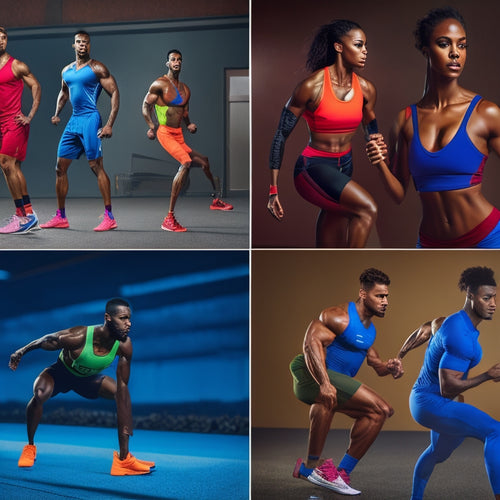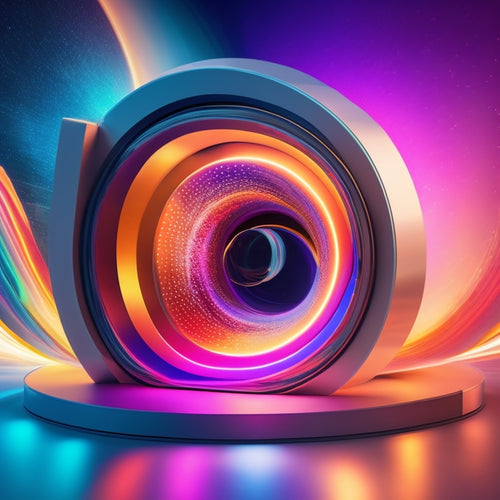
Can I Practice Dance Without Mirror?
Share
You can practice dance without a mirror, and it may even enhance your skills. Without visual feedback, you'll develop a deeper connection with your body and its movements, tapping into your proprioception to sense position and movement. This can help you cultivate a more intuitive sense of movement, trusting your internal sensations to guide your movements. By letting go of visual reliance, you'll engage your kinesthetic sense, feeling movement instinctively. As you explore this new approach, you'll discover more about your body's capabilities and reveal new levels of expression and fluidity in your dance.
Key Takeaways
• Develop a deeper connection with your body and its movements by practicing without visual feedback to tap into proprioception.
• Incorporate blindfold exercises to challenge your reliance on visual feedback and cultivate an intuitive sense of movement.
• Tune into physical sensations, letting subtle cues guide your movements, and focus on muscles, joints, and bones sensations.
• Rely on your kinesthetic sense to feel movement instinctively, trusting internal sensations to guide your movements.
• Practice breath control, body scan, and mindful movement to connect with your body on a deeper level.
Practicing Without Visual Feedback
As you shift your focus away from mirrors, you're forced to rely on internal sensations, developing a deeper connection with your body and its movements. This allows you to tap into your proprioception, or your body's ability to sense its position and movement.
Proprioception exploration becomes essential, helping you develop a more precise understanding of your body's capabilities. To take it a step further, try incorporating blindfold exercises into your practice. This will challenge your reliance on visual feedback, forcing you to trust your internal sensations and intuition.
As you practice without mirrors, you'll begin to develop a more intuitive sense of movement, freeing you from external distractions and allowing you to connect with your body on a deeper level.
Developing Internal Body Awareness
Developing internal body awareness requires you to tune in to your physical sensations, quieting your mind and letting your body's subtle cues guide your movement. This means focusing on the sensations in your muscles, joints, and bones, rather than relying on visual feedback.
To cultivate internal awareness, try these exercises:
-
Practice breath control, focusing on the sensation of air moving in and out of your body
-
Perform a body scan, lying or sitting comfortably, and notice areas of tension or relaxation
-
Engage your core muscles, feeling the connection between your pelvis, lower back, and abdominal muscles
- Move slowly and mindfully, paying attention to the subtle sensations in your body as you shift your weight or change direction
Relying on Kinesthetic Sense
By tuning into your internal body awareness, you're now ready to tap into your kinesthetic sense, allowing you to feel the movement and respond instinctively, rather than relying on visual cues. This proprioceptive awareness enables you to sense the position and movement of your body in space, freeing you from dependence on mirrors. Through somatic experience, you can develop a deeper connection with your body, trusting your internal sensations to guide your movements.
| Aspect | Description |
|---|---|
| Kinesthetic sense | Feeling the movement and responding instinctively |
| Proprioceptive awareness | Sensing the position and movement of your body in space |
| Somatic experience | Developing a deeper connection with your body |
| Freedom | Dancing without relying on visual cues or mirrors |
Using Technology for Correction
You can tap into digital tools to refine your movements, leveraging technology to pinpoint and correct subtle imperfections that might've gone unnoticed without a mirror. This allows you to focus on specific areas of improvement, freeing you from the constraints of traditional mirror-based practice.
With the help of technology, you can:
- Record yourself dancing and analyze your movements frame by frame
- Use mobile apps that provide personalized feedback on your technique
- Utilize virtual assistants to track your progress and offer suggestions for improvement
- Access online tutorials and classes that cater to your specific needs and goals
Focusing on Musicality and Timing
As you shift your attention to the nuances of musicality and timing, focus on internalizing the rhythm and letting it guide your movements, allowing you to fully embody the music. This is where you can truly express yourself and connect with the rhythm.
Developing your rhythmic expression requires a strong sense of beat awareness, so practice tapping into the pulse of the music. As you move, focus on the rhythm and let it dictate your timing. Don't worry about perfect execution; instead, prioritize feeling the music and letting it move you.
The more you connect with the rhythm, the more authentic and free your movements will become. By focusing on musicality and timing, you'll reveal a deeper level of expression and freedom in your dance.
Building Confidence Through Repetition
Through consistent repetition, your body starts to internalize the movements, and with each iteration, your confidence grows. As you repeat the steps, your muscles memorize the actions, allowing you to execute them with more precision and ease. This process enables you to shift your focus from mere execution to expression and artistry.
Some benefits of repetition include:
-
Mental rehearsal: Visualizing yourself performing the choreography helps solidify the movements in your mind, making it easier to recall during practice.
-
Self-reflection: Regular repetition allows you to identify areas for improvement, refine your technique, and develop your unique style.
-
Muscle memory: Consistent practice helps your body adapt to the movements, reducing the need for constant mental effort.
- Freedom to express: With confidence in your movements, you can focus on conveying emotions and telling a story through your dance.
Improving Alignment and Posture
Proper alignment and posture serve as the foundation of strong, efficient, and expressive dance technique, allowing you to execute movements with precision and control. By focusing on your posture, you'll improve your overall dance quality. To achieve good alignment, engage your core and maintain a neutral spine. This will help you maintain balance and stability.
| Alignment Focus | Tips for Improvement |
|---|---|
| Engage Core | Activate your transverse abdominis muscle to support your lower back. |
| Neutral Spine | Imagine a string pulling your head towards the ceiling, lengthening your spine. |
| Shoulder Relaxation | Release tension in your shoulders, keeping them down and away from your ears. |
| Breath Control | Take deep breaths, filling your lungs fully, and exhale slowly to maintain control. |
Engaging Core Strength and Control
You'll build a stronger, more stable dance foundation by developing core strength and control, which will enhance your overall alignment and posture. This is vital for practicing dance without a mirror, as it allows you to focus on internal sensations rather than visual cues.
By engaging your core, you'll improve your overall stability and control, enabling you to move with more precision and freedom.
Here are some key aspects to focus on:
- Breath control: Practice deep, controlled breathing to calm your nervous system and engage your core.
- Pelvic stability: Engage your pelvic floor muscles to maintain a stable, neutral pelvis, essential for balanced movement.
- Core activation: Activate your transverse abdominis muscle to support your spine and maintain good posture.
- Body awareness: Develop awareness of your body's position in space, allowing you to make adjustments and corrections without relying on a mirror.
Enhancing Spatial Awareness Skills
As you work on enhancing your spatial awareness skills, you'll focus on developing body awareness and spatial mapping.
You'll learn to sense the position and movement of your body in space, allowing you to make precise adjustments and execute complex movements with confidence.
Body Awareness
By tuning into your internal sensations and kinesthetic feedback, you can refine your body awareness, allowing you to better navigate your physical space and execute movements with more precision and control. This heightened sense of body awareness is essential for dancing without a mirror.
Through body scanning, you can develop a deeper understanding of your somatic experience, allowing you to:
- Identify areas of tension and release them
- Develop a sense of spatial orientation
- Improve your balance and coordination
- Enhance your overall physical awareness, leading to more fluid and expressive movements
Spatial Mapping
Spatial mapping enables you to mentally chart your body's position and trajectory in space, allowing for a more precise and intentional execution of movements. This skill is essential for dancers, as it enhances your spatial awareness and freedom of movement. By creating mental blueprints of your body in space, you can navigate virtual environments with ease, even without a mirror.
| Benefits | Description |
|---|---|
| Improved Spatial Awareness | Develop a deeper understanding of your body's position in space |
| Enhanced Movement Execution | Execute movements with precision and intention |
| Increased Freedom | Move with confidence, even in unfamiliar environments |
Cultivating Mindfulness in Movement
You cultivate mindfulness in movement by paying attention to the subtle sensations in your body as you execute each step, allowing you to refine your technique and deepen your connection with the dance. This awareness helps you tune into your breath, letting go of tension and finding ease in your movements.
As you practice, focus on:
-
Breath awareness: notice how your breath moves in and out of your body, influencing your movements
-
Mindful passages: pay attention to the flow between steps, creating a seamless dance experience
-
Body awareness: tune into the sensations in your muscles, bones, and joints, refining your technique
- Inner guidance: trust your inner wisdom, letting go of self-doubt and embracing your unique expression
Frequently Asked Questions
Can I Still Learn Choreography Without a Mirror?
You can absolutely learn choreography without a mirror! By focusing on muscle memory and spatial awareness, you'll develop a stronger connection to your body, allowing you to master moves without visual cues.
How Do I Correct My Form Without Visual Feedback?
You focus on developing kinesthetic awareness, trusting your body's internal sensations to guide you, and practice body mapping to correct your form, relying on internal feedback rather than visual cues.
Do I Need to Practice in Front of a Mirror Sometimes?
You don't need to practice in front of a mirror all the time, but occasional mindful practice with a mirror helps develop self-awareness, allowing you to make adjustments and refine your technique with confidence.
Can I Still Get Feedback From Instructors or Peers?
"Break a leg" and get ready for constructive criticism! You can still get valuable feedback from instructors or peers through peer review and instructor guidance, helping you refine your craft and take your dance skills to the next level.
Will I Struggle to Master Complex Dance Moves?
You won't struggle to master complex dance moves; you'll develop muscle memory through repetition, and spatial awareness will improve with practice, allowing you to focus on technique and expression, even without a mirror.
Related Posts
-

Essential Performance Apparel for Every Gym Session
Choosing the right performance apparel is essential for maximizing your gym sessions. Look for moisture-wicking mater...
-

Issuu's Dynamic Flipbook Creation: Engage & Share
Issuu's dynamic flipbook creation platform revolutionizes digital content creation, offering an intuitive and seamles...

